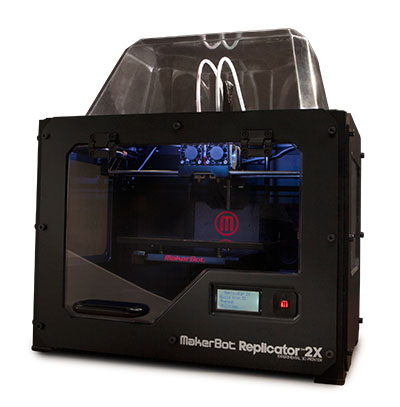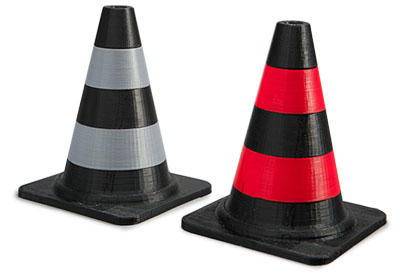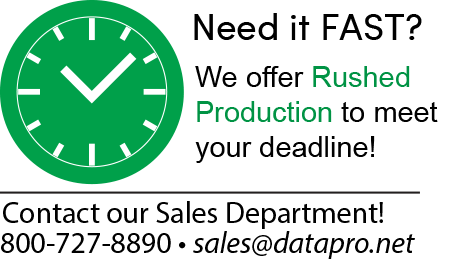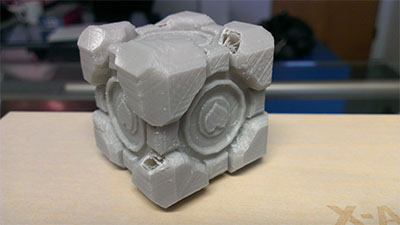|
This unofficial manual was written by a member of our staff in 2014, as a kind of supplement for anyone in the office wanting to play with our new Makerbot Replicator 2X. It should not be used as your sole instruction manual, and may be a little out of date in places.
We use our 3D printer to prototype parts, and can produce CNC milled and injection molded final products in single units, or we can scale up to full production runs. For more information about our capabilities, see our Custom Wallplates, Custom Panels, and Custom Cable pages!. What is 3D Printing?3D printing is a manufacturing process in which 3D models developed on a computer are built up, layer by layer, by a machine using one of several additive processes. There are three primary additive processes right now: FDM (Fused Deposition Modeling), SLS (Selective Laser Sintering), and SLA (Stereolithography). Each process has its own benefits and drawbacks, but the machine we chose to start with, a Makerbot Replicator 2X, is an FDM machine that can print in ABS plastic (the same material used for LEGO) and PLA (a biodegradable starch-based plastic). FDM machines pull their print material into the extrusion head in the form of a filament, melt a small amount, and deposit it on the build platform.The Replicator 2X Our 3D printer is a hobbyist-level machine, so it costs about $2700 and the spools of print material are about $40 per 1kg spool (this is pretty cheap). The important parts of the specs are as follow: Our 3D printer is a hobbyist-level machine, so it costs about $2700 and the spools of print material are about $40 per 1kg spool (this is pretty cheap). The important parts of the specs are as follow:
Accuracy
Build Volume
Build Platform Before Printing1. ConceptualizingWhen you are struck with an idea that you'd like to print, try and think it through several times before committing it to plastic. Make some sketches, ask some people for input, and try to picture using it in the real world. A fully fleshed out concept will save you time and money in the long run if you do as much problem solving as possible before you start modeling and printing.
2. Modeling
The Replicator 2X itself only understands files in .x3g format, which is the file type output by the Makerware software. Makerware will generate .x3g files from .obj, .stl, and .thing files. Using many of the above pieces of software, you will need to export your model first, and convert it to .x3g using Makerware.
Models Already Available
Makerware
Printing Loading and Unloading Filament Spools Loading and Unloading Filament SpoolsThe spool holders on the rear of the printer are detachable, so if the printer is in an awkward position you can simply remove the spool (after you've unloaded the filament from the extrusion head). The holders are tension-locked, so to put a spool on or remove it, you must pinch the ends of the holder together. This can be difficult and painful if your hands are too big. Enjoy!
Loading and Unloading Filament
Cleaning and Clearing the Extrusion Heads
Cleaning and Clearing the Build Platform
Removing Your Print
Resetting The Printer
Finishing a PartThe X-acto KnifeLots of prints that come off of the Replicator 2X will have burs, supports, and helper discs that need to be trimmed. The cleanest way to do that is to use an X-acto knife set. It's easy to get stuck in a perfectionist loop, trimming and rounding for hours, but this loop has several problems: First, you can over-trim a part, and there's no going back from that. Second, if you spend hours on end fixing print after print after print, pretty soon whichever hand you hold the print in is going to hate you. The X-acto knife can make your print look great if you're careful, but try to avoid the thought process that always lands you back at "If I just trim one more thing..."
Acetone
Printer MaintenanceKapton TapeThe yellow/orange tape that helps parts adhere to the build platform is called Kapton Tape, and it can be a little tricky to apply. You will need to apply tension to the tape and smooth it onto the build platform until you have a smooth and even surface for prints to rest on. It goes on like a window decal or a cell phone screen protector. Kapton tape should be usable for quite a while, barring screwdriver-related print removal accidents. When the tape is sufficiently used up, just peel it off of the platform and throw it away. The tape on hand may not always be the correct width for the build platform, in which case you may need to apply more than one piece. Just try to keep the seam as small and smooth as possible, and everything will be fine.
Hairspray
The Extrusion Heads
Lubrication
Bed Calibration - Primping Ain't Easy
Troubleshooting and PitfallsFilament JamsWhen an extrusion head is making a clicking sound, that means there is probably a filament jam. These jams are sometimes caused by a bad bed calibration, sometimes by material buildup around the nozzles, and sometimes by some oddity of the model you are trying to print. Determining which of the possible causes is to blame is sometimes a bit of trial and error, but it can be as simple as changing the orientation of the print on the bed. Fixing the jam itself is easily done: run the Unload Filament script in Utilities, cleanly cut the filament after pulling it out of the extrusion head, and then run the Load Filament script. Make sure you clear the nozzle before running the loading script.
Unexpected Extrusion Head Movement
Keep An Eye on the Filament Spools
Garbled Text on the Front Panel
Multi-Part Print Jobs |
|
Unauthorized duplication prohibited. If you wish to reproduce this article in whole or in part, please Contact us. |
|
||







